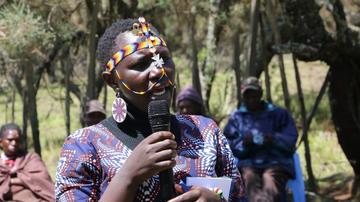How can we advance rights-based conservation?
Researchers are working with Indigenous colleagues to highlight the contributions made to conservation by Indigenous peoples, and what successful partnerships can look like.
In April 2023, two Indigenous Biodiversity Fellows arrived in Oxford from Kenya for a three-month Fellowship with the Department of Biology. Elijah Kitelo and Phoebe Ndiema work for Chepkitale Indigenous Peoples' Development Project (CIPDP), an organisation focused on the rights of the Ogiek of Mount Elgon, Kenya, and are working with researchers in the Department’s Interdisciplinary Centre for Conservation Science (ICCS) to develop tools and procedures to monitor biodiversity on their lands. The Ogiek have been forcefully evicted from their lands to make way for conservation, despite their remaining lands being in better condition than the areas from which where they were evicted. Elijah explains:
If you go to Mount Elgon you will see that the environment where the community resides is in a much better condition than areas that are managed externally for conservation, because of the ways they are trying to manage it. The community became victims of the agents of conservation who say that Indigenous communities don’t conserve, and yet, the area the communities have ceded to these people is worse managed.
However, Elijah and Phoebe understand that to gain recognition for their contributions to conservation, they need to document the biodiversity gains in ways that are recognised by conservation scientists. They are now working closely with researchers from ICCS to build their technical skills to monitor biodiversity in their home communities. Phoebe explains:
There is a need to show the world that we can conserve better using traditional knowledge, and we can monitor our biodiversity well. Ogiek people are forest-dwelling, and we see biodiversity as a source of food, of medicine, as a friend…our elders normally say that we are part of the ecosystem so we’d better conserve the environment. Truly, Indigenous people have the knowledge to know how to manage their environment and we need to be given enough support to prove that.

As part of her work, Phoebe speaks to other Indigenous people to bring their voices into conservation discussions
The case of the Ogiek is not unique – forced evictions and other rights violations in the name of conservation are widespread, despite overriding evidence of the important roles of many Indigenous peoples and local communities as biodiversity custodians and partners in conservation. However, in December 2022, in what was hailed as a major breakthrough in global policy, governments from around the world committed to a human rights-based approach to all aspects of conservation implementation as part of the new Kunming-Montreal Global Biodiversity Framework.
So how can we advance rights-based conservation? Over the past 18 months, members of the Department of Biology have collaborated with the human rights organisation Forest Peoples Programme and the editorial team of the academic journal Oryx, to put together a special issue of the journal on conservation and human rights. Published in May, the issue includes articles written jointly by academic and Indigenous authors which illustrate different issues on this topic, including an article on the situation at Mount Elgon. There are four main themes:
-
Embracing international law on rights
Respecting rights as they are set out in international law is the defining characteristic of a rights-based approach. In the Mau Forest in Kenya, the African Court of Human and Peoples’ Rights ordered the Kenyan Government to grant the Ogiek collective title to their ancestral lands. The ruling recognised that the Ogiek are the ancestral owners of the Mau Forest, that there was no evidence that they were responsible for Its destruction, and that they must be part of any decisions made regarding their future.
-
Building on common interests
Indigenous peoples contribute to conservation in a variety of ways based on their traditional knowledge systems. Successful partnerships can be seen through, for example, long-term collaboration based on mutual respect and detailed consultation, ensuring that management actions align with traditional practices.
-
Engaging in discussion about conflicts of interest
It is critical that conservationists listen to testimonies directly from the people affected by their decisions, and that dialogues are ongoing at local, national, and regional levels as new issues arise. Open, evidence-informed discussion can be difficult to achieve, especially where there is a history of rights violations, but innovative tools can help with this, such as participatory video, Indigenous-led listening events, and collaborative assessments on the ground using the Whakatane mechanism – a dispute resolution mechanism that has been adopted by the International Union for the Conservation of Nature (IUCN).
-
Earning trust
Given the history of rights violations in conservation, it will take time for conservation actors to earn trust. This should include considering how to remedy past long-term rights violations and move towards greater support for local people to address their own conservation priorities. Academic researchers have a key role to play, ensuring that research is collaborative, inclusive, and adheres to good practice, as well as opening new spaces for Indigenous peoples to engage in discussions.
This is the first joint Indigenous-academic issue of a conservation journal with global coverage, a fact which highlights the lack of Indigenous voices in academia; this absence from academic spaces exacerbates the disconnect that conservation actors have with the contributions of Indigenous peoples. The collaborators hope that more follow, and that it provides conservationists with a framework for advancing rights-based conservation in their own fields.
Part of the solutions we seek lie in listening more, providing space for Indigenous and community values, perspectives and priorities, and—crucially—recognising and embracing the rights and leadership roles of Indigenous Peoples and local communities in setting humanity on a better course. This includes in academic spaces such as this journal, and we are pleased to see this human rights and conservation theme setting an example. (From Tugendhat et al. 2023)
To read more from this issue of Oryx, visit: https://www.cambridge.org/core/journals/oryx/issue/2C7954E5544A36301B4E0FABF9721361


